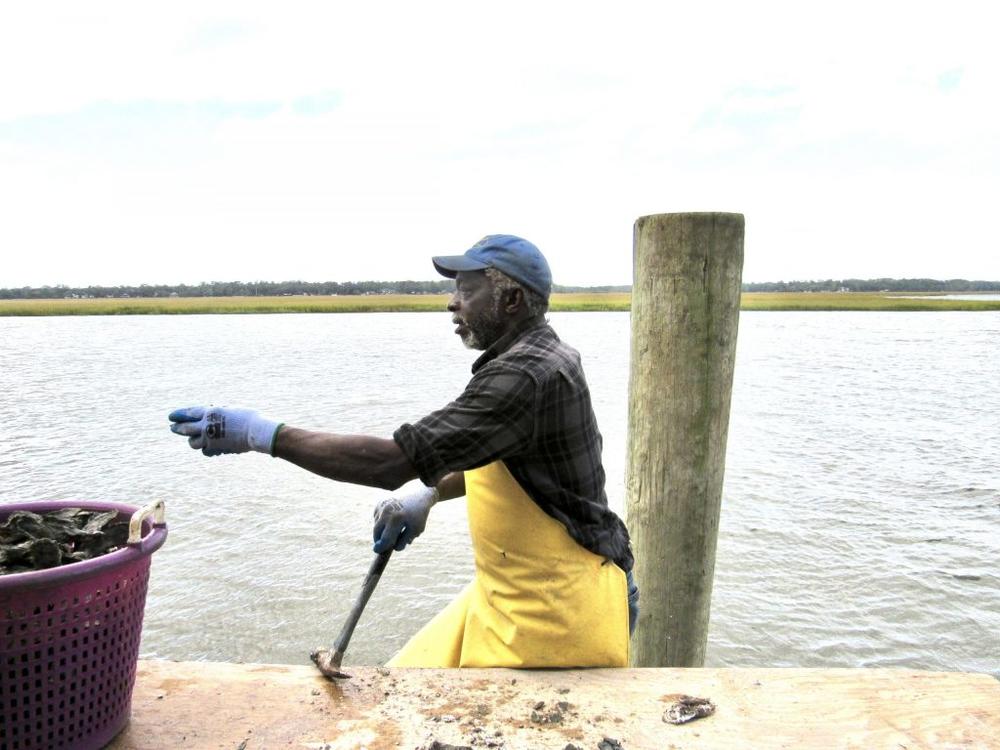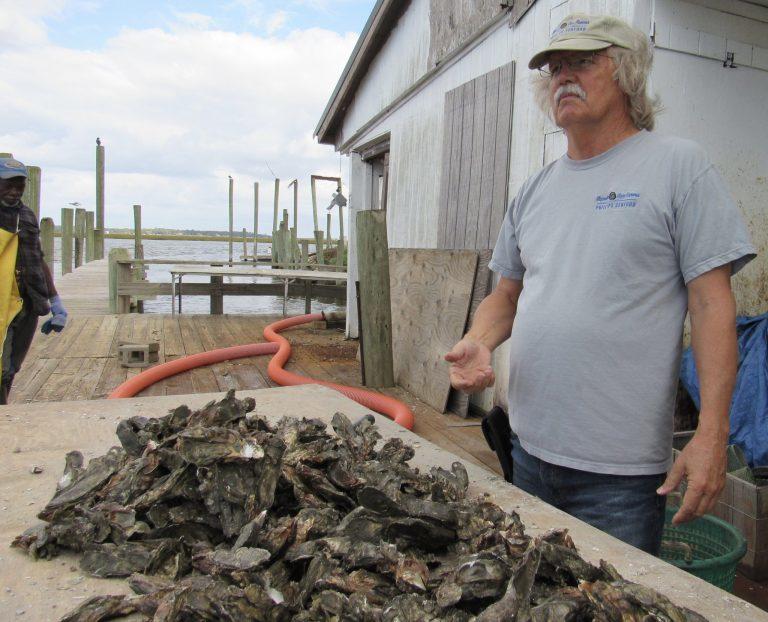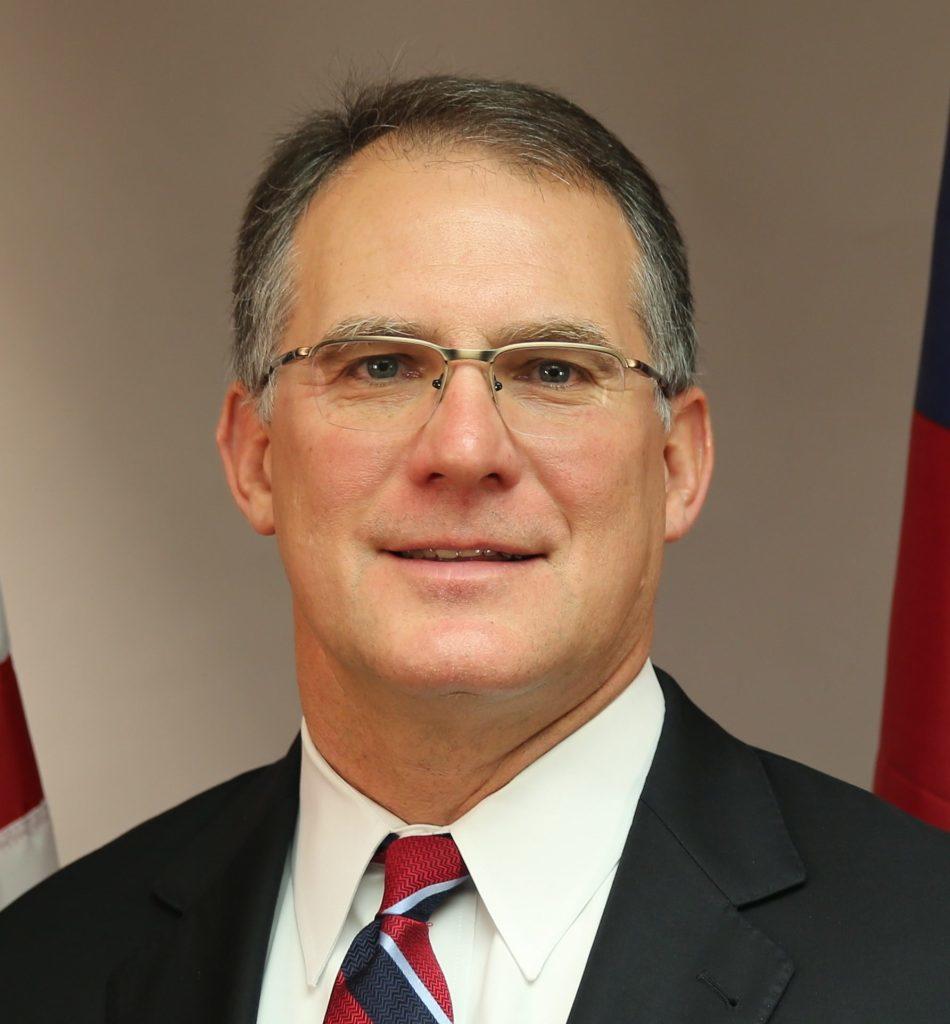
Caption
In Townsend, Herman Armstrong of Sapelo Island, uses a hammer to break up clusters of local oysters at Sapelo Sea Farms in McIntosh County.
Credit: Bert Roughton/The Current

In Townsend, Herman Armstrong of Sapelo Island, uses a hammer to break up clusters of local oysters at Sapelo Sea Farms in McIntosh County.
The man who wants to put more oysters on restaurant platters says Georgia lawmakers may be trying to put a lid on his business.
When Bob Rheault, executive director of the East Coast Shellfish Growers Association, saw legislation written to legalize oyster farming in Georgia, he said his first thought was: “They don’t really want an industry, do they?”

State Rep. Jesse Petrea
Rheault, some environmental groups, and shellfish farmers say Georgia’s new industry could be sunk before its launch by onerous regulations and the 2019 legislation that created it. Lawmakers and state officials dispute that charge.
State Rep. Jesse Petrea, R-Savannah, the bill’s chief sponsor, said the nay-sayers “are frightened about something that there’s no evidence to prove yet.
“The proof will be in the pudding,” he said. “A year from now, we’re going to have people beginning the process of farming oysters.”
Georgia officials have been talking for decades about legalizing oyster farming and joining other coastal states in cashing in on an insatiable craving nationally from raw bars and upscale restaurants for single oysters.
They are a year behind schedule on the first major step – issuing leases on the coastal waters where shellfish growers can raise oysters from seed in 12 to 18 months. And with major details of the new industry still being ironed out, they have abandoned the goal of having 50 Georgia shellfish farmers churning out farm-grown oysters worth $5 million a year by 2022.
Jill Andrews, the state Department of Natural Resources’ chief of coastal management, recently said that forecast was an “aggressive, best-case scenario,” hinging on new state funding that has taken years to secure and on government functioning normally, not in pandemic mode.
Environmental groups and shellfish growers formed what seemed an unlikely alliance in 2019 to oppose House Bill 501, which DNR wrote and patterned after South Carolina’s oyster farming law.
One controversial provision of the bill creates a lottery to determine who will be awarded 10-year water leases, the locations of which will be determined by DNR, not growers. Another requires special permits to harvest oysters in the warmest months of the year, June through September. And still another part was criticized for appearing to force growers to buy their oyster seed only at a hatchery near Savannah started by the state in 2015 – something DNR officials say they have clarified in new rules that permit the use of approved, out-of-state seed.
Alex Muir, advocacy coordinator for the coast’s non-profit One Hundred Miles, said a lottery could put any business owner or investor at “very high risk.”
“Potential growers are required to invest heavily in capital to enter a lottery in which they may not even receive a lease,” she said.
Bryan T. Rackley, co-owner of Decatur’s Kimball House restaurant and founder of the growers’ alliance Oyster South, said that was one of his concerns. He hopes to one day have a small oyster farming operation that can supply his restaurant, and possibly others.
“You kind of need a sure thing if you’re asking an institution to loan you money,” Rackley said.
Fletcher Sams, executive director of the environmental group Altamaha Riverkeeper, said the new law – which became effective March 1 — puts Georgia oyster farmers at a competitive disadvantage out of the gate by failing to guarantee their customers a year-round harvest.
“I have a hard time understanding why the legislature would pass legislation that is not beneficial,” Sams said. “But they did.”
State officials are being cautious because raw oysters have been linked to Vibrio parahaemolyticus and Vibrio vulnificus, pathogens that can cause illness and death in people and are found in higher concentration during the summer months as ocean water becomes warmer, said Dominic Guadagnoli with the DNR’s Coastal Resource Division’s Shellfish and Water Quality Program.
Eight companies are currently harvesting or have plans to harvest wild oysters in Georgia.They could be impacted by the creation of the new industry, simply because more suppliers mean more competition. But how much competition is unclear since wild oysters aren’t typically sold to restaurants, state officials say.
Rheault, whose organization includes shellfish growers from Maine to Florida, said Georgia has chosen an “odd way” of distributing the leases.
In most states, he said, the farmer picks a spot to grow oysters based on factors such as ease of access, water quality, the absence of competing uses, and water flow. Once a formal application is made, a public hearing can be held and anyone with objections to the lease can be heard.
“Like restaurants, aquaculture success is all about location, location, location,” he said, adding that most growers want to be near their boat launches or docks.
Trey McMillan, owner of Lowcountry Oyster Co. near Charleston, S.C. is not sure his state should have been Georgia’s model.
“It’s so backward here,” said McMillan, who pre-pandemic was shipping 5,000 to 7,000 oysters a week to a dozen restaurants in the Savannah area.

In Townsend, Charlie Phillips, owner of Sapelo Sea Farms, is hoping to be among the first to take part in Georgia’s revived oyster industry.
For example, Virginia and Chesapeake Bay offer shellfish farmers tax credits for reducing the nitrogen in the water, he said.
“They actually support [oyster farming], where a lot of the state agencies here fight it,” McMillan, vice president of the South Carolina Shellfish Growers Association.
Only about five South Carolina companies are farming oysters in cages.
“There aren’t a bunch of people beating down the door to try to do it,” said McMillan, who, four years into it, still finds the bureaucratic process a challenge.
“One [agency] wants one thing, another something else,” he said. “They kind of end up contradicting each other, and you end up chasing your tail in circles.”
The Riverkeeper’s Sams is hoping to find a lawmaker in 2021 willing to propose needed revisions to the law, something Petrea does not see happening.
“The coastal delegation to a man supported the bill,” Petrea said. “The only one who didn’t was [Brunswick state Rep.] Jeff Jones who is no longer in office.”

Sen. William Ligon, Jr. of Brunswick
Sen. William Ligon Jr., R-Brunswick, who introduced an identical bill to Petrea’s in the Senate, said: “There has not been a clamor for any changes to be made that has been brought to my attention.”
Eighteen months after the legislature passed Petrea’s bill, DNR has not established the criteria for the lottery, including the “priority points” that are to give an advantage to Georgia-grown applicants and existing shellfish growers.
These rules are being developed by DNR in consultation with the Shellfish and Mariculture Advisory Panel, a group that includes some current shellfish growers. They have not met, however, since October 2019.
“The next time the AP convenes, this will be an important item to discuss,” said Andrews, the DNR’s coastal management chief..
Another hurdle is figuring out what parts of the coastal waters to lease, Andrews said. She said that will be a “very deliberate and purposeful” process because a lot of people are already using the waterways.
Charlie Phillips, owner of Sapelo Sea Farms, the state’s largest clam farming operation, plans to enter the lottery and try his hand at raising oysters. Phillips opposed the 2019 legislation but had a change of heart after meeting recently with DNR officials and learning more about their plans.
“I can see daylight now, and I did not see daylight before,” he said. “lt looks like I can play, though it won’t be as easy as I would like it to be.”
Georgia’s oyster farming industry is on pace to crank up while oyster farmers are still rebounding from the coronavirus’ effects on their biggest customers — restaurants.
Shellfish farmers on the East Coast were collectively making about $163 million a year – 55% from growing oysters – when the pandemic hit. Almost overnight, 98% of sales evaporated, Rheault said.
He is telling current oyster farmers not to buy any new gear or take on any new debt. He also is lobbying USDA to buy some of the industry’s oversupply and giving some to food banks.
Long-range, he said, Georgia and other Southern states have a product with the potential to give the Northeast’s oyster growers a run for their money.
“You have some great growing areas down there with huge tides,” Rheault said. “The South has the potential to kick our butts.”
This story comes to GPB through a reporting partnership with The Current, a non-profit newsroom covering Coastal Georgia.